Don't wanna be here? Send us removal request.
Text
Hiding in the Malaysian jungle
Exactly a year ago today, we woke up in the middle of Malaysia’s vast Taman Negara national park, miles away from any humans, surrounded by lush tropical jungle. Still in our sleeping bags, we looked around in the wooden hide, high up in the canopy, and all we could see was 12 bunk beds (no mattresses, that’d be a luxury we’d definitely not paid for), our clothes all over the place and some blood on the concrete floor.
18 hours earlier
We’re sitting behind each other in a small motorboat, expertly navigated by a Malaysian guy in the back, his partner sitting in the front, looking at what seems like a huge tropical thunderstorm right ahead of us. And we’re heading straight towards it.
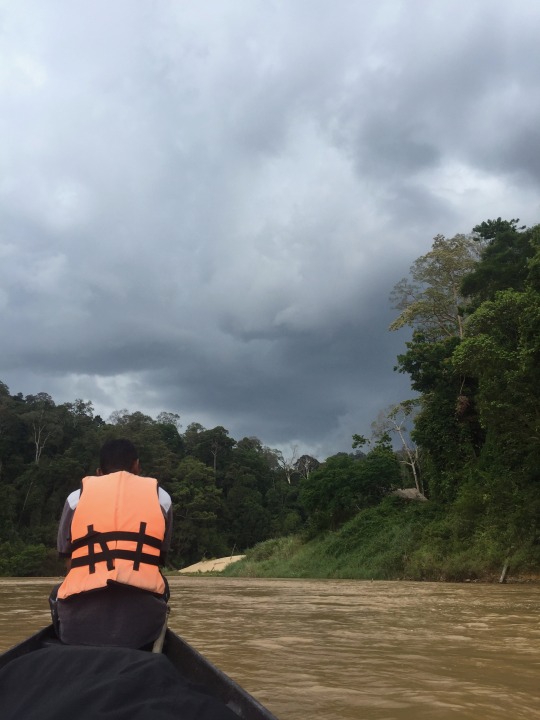
Soon, these guys will drop us off somewhere on the riverbank, and we’ll be left on our own to trek to the animal hide where we’ll spend the night completely alone.
No, this is not Survivor, there are no cameras here. (Apart from our shitty iPhones and our trusty GoPro.)
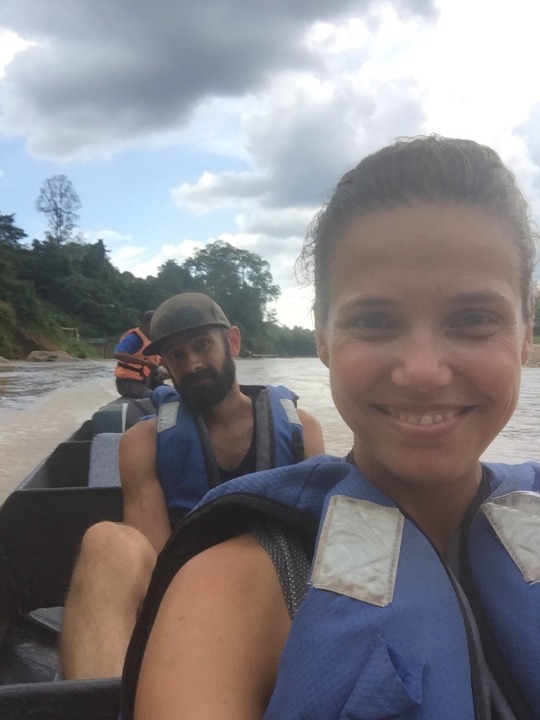
We came to this jungle with the aim to go ‘off the beaten track’, one of MJ’s mantras for our trip. Taman Negara is Malaysia’s biggest national park. Whilst it’s very popular and there are lots of swanky accommodation options, what we decided to do was spend a night away from civilisation, in one of the observation towers hidden in the jungle. If we’re lucky, we’ll get to see tapirs, gaurs and deer, and if we’re really lucky, we won’t be murdered by a fellow traveller / monkeys / spiders / a rabid and carnivorous tapir. Or who knows what? It’s the bloody jungle, after all!
But first, the boat trip. We’ve reached the centre of the storm and got suitably wet - a great start. Then once the rain stops, we reach our destination. Classic. We’re dropped off at a small jetty where we meet a small group of travellers waiting for a boat to take them back to the village. They tell us they spent the night in a cave, which is exactly what they look like. The Dutch bloke (there’s always a Dutch bloke) points to his feet: first of all, he’s wearing flip flops, an odd choice in the jungle (is he an Aussie in disguise?), but more disturbingly, his fleet are bleeding from what looks like leech bites. At this point they confirm that yes, the forest floor is heaving with leeches. This information shocks me, and me alone - MJ simply nods and reveals that he chose not to share this vital piece of information with me, lest I change my mind and get on the next coach back to civilisation. He knows me so well.
At this point our boat is gone, along with our chance to escape. Always the semi-adventurous travellers, we didn’t arrange a boat transfer back, thinking it’d be a great idea to trek back after a night spent animal watching.
So here we are, stuck in the jungle, soaking wet, millions of leeches waiting to jump on us from left, right and centre. Suddenly the idea of the abandoned hide seems very appealing. We start trekking.
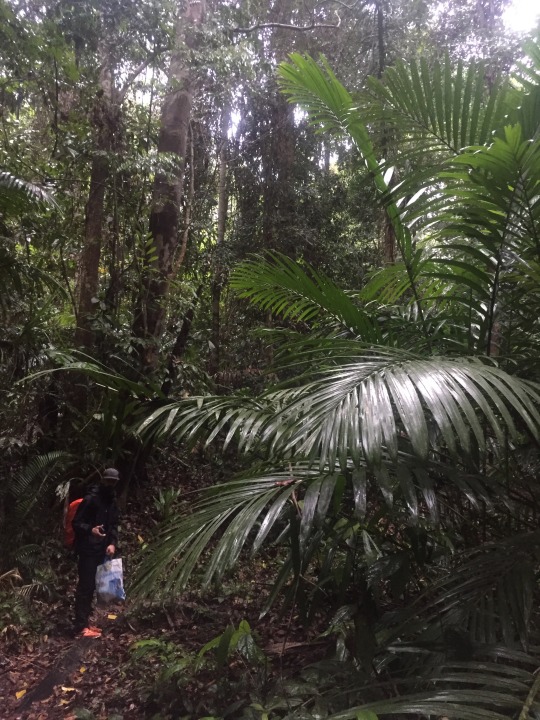
The problem with leeches, well, one of the many problems with leeches, is that they’re tiny. You think you’d spot them from a few metres, or that you’d see the little bastard trying to get onto your skin to have a nibble. But no, they’re tiny, so you can’t see them, so you’ll end up thinking they’re EVERYWHERE. Which is kind of the case. They hang on to the back of leaves, so if you brush a leaf with your shoulder, they’ll latch onto you. They’re also on the jungle floor, waiting for you to step on a leaf - and boom, they’re on your shoelace, then before you know it, they’re INSIDE YOUR SHOE, then by the time you’ve taken off your shoes, they’ve had a lovely 3 course dinner, thanks very much, that was delicious, what’s for pudding?

It’s nearly dark by the time we reach a little clearing with a creepy looking wooden structure on high stilts. It looks exactly like something from a horror movie, but it’s either this or the leeches so up we go. At the top of the stairs, there’s yellow police tape, but no door (it’s been ripped off and put aside) - the place looks like a crime scene cordoned off by the police. Inside it’s totally empty, bar the wooden bunk beds (very uninviting) and a bench by the window. But there’s no time to get cosy anyway, it’s de-leeching time.
We get butt naked (thank the Lord for the complete lack of fellow travellers in the hide) and as suspected, we find leeches all over us: in our armpits, between our toes, holding on to our socks. It’s disgusting. When you tear one off from your skin, the bite mark starts bleeding. When they’re on the floor, they keep twisting and curling, like some worm possessed by an evil spirit. We locate a wooden stick and start killing them one by one. This is when we realise how much blood they managed to suck in: it’s now all over the floor. By the time we think we’re done, it does look like a crime scene - if someone entered now, they’d think we’d gone mental.
All this excitement made us quite hungry so we unpack our humble dinner (think sweet Malaysian bread and tinned curry) and settle down by the observation station to eat. There’s not much to do in the hide, other than stay quiet, wait for it to get dark and hope for wildlife to appear.
The hide is built next to a clearing with a salt lick - this is what will attract all sorts of animals at night. You should hear tapirs scrambling in the bushes, at which point you shine your torch and hope to see something.
It doesn’t help that it started raining again, and the tin roof of the hide acts like a Dolby Surround Sound System - we can’t hear our own voice let us alone some tapir 50 metres away..
Anyway, we’re waiting patiently, and enjoying our solitude. Knowing that there’s literally no human being within at least 10km of us, only the jungle with its animals, should make us feel safe, but we’re in uncharted territory, and we’re definitely not the ones at home here. The jungle is not only massive, but alive and noisy. We can hear monkeys rustling in the canopy around the hide, but we can’t see them. The lack of doors makes me think they can come in any time, and why wouldn’t they? If I was a Malaysian monkey, I’d love some sweet Malaysian bread please. We pack our remaining food away.
Around 11pm, the conditions are finally just right for some wildlife spotting. The rain has stopped, the air smells fresh and humid, and we’re eager to explore the jungle from the relative safety of the hide. We position ourselves next to the long window overlooking the clearing. Torch in hand, we take turns in shining it around in the darkness every minute. The stampede we were envisaging is definitely not happening, although we ‘think’ we see some shiny things on the ground, but they might be spiders, or drops of rain, who knows.
Then, after like an hour of waiting, we suddenly spot a pair of eyes shining in the bushes. They quickly move but then we spot a little animal, hopping over a small bush with an ungraceful but insanely cute motion of its backside. We conclude it was a tapir. Photographic evidence aside, you have to believe us, dear reader. Told you we had shitty iPhones!

0 notes
Text
Hanging with orangutans in Borneo
One of the main reasons we came to Borneo was to attempt to catch a glimpse of their world famous orangutans. If you watch Our Planet by the legend that is Sir David, you might know that wild orangutans are only found on the islands of Sumatra and Borneo. The Bornean orangutan was classified as a critically endangered species in 2016, after around 150,000 of them disappeared from the island in 15 years. Due to loss of habitat, logging and poaching, these wonderful animals are facing a huge challenge - but there’s hope.

We wanted to find a place where orangutans can still be seen in their natural habitat, so after some research we decided to travel to Sabah, in North-West Borneo. First, we went to a remote little village on the Kinabatangan river. The rainforest along the river (a total of 26,000 hectares) has been a protected area since 2005 and is a haven for wildlife. Local guesthouses offer river cruises with knowledgeable guides who have crazy skills in spotting animals in the forest. Of course there’s no guarantee that you’ll see anything, but that’s the beauty of it: it’s not a zoo.

We were incredibly lucky and spotted lots of amazing animals including a massive crocodile, beautiful birds such as the Rhinoceros Hornbill, and groups of the funny-looking Proboscis monkeys unique to Borneo. That would’ve been worth the trip already.

But on the second day, ten minutes into our afternoon cruise, our guide suddenly stopped our boat and pointed to the canopy of a massive tree. And there it was: a young orangutan, casually sitting on top of a tree, munching on leaves and tree bark. He was not bothered by our boats as we quietly approached the riverside to get a better look and attempt to take some photos - an epic fail, thanks to our mediocre iPhone cameras.

To be able to observe an orangutan in the jungle was such an incredible experience and something we’ll always remember.
When you only have one week in Borneo and you know that you might not have the opportunity to come back in your life, you want to maximise your chances of seeing an orangutan. The easiest way to do it is to go to a rescue centre. We had mixed feelings about this but after some deliberation we decided to visit the Sepilok Orangutan Rehabilitation Centre.
It’s located at the border of a huge protected area of rainforest and they’re doing an incredible job to rehabilitate orphaned and injured orangutans that otherwise wouldn’t stand a chance in the wilderness. They successfully release around 66% back into the wild and the only orangutans that remain around the centre tend to have some serious illness or disability that would make their survival in the jungle unlikely.

The centre opens its doors twice a day allowing visitors to watch the morning and afternoon feedings, or see the young orangutans in the unfenced outdoor nursery from behind a smoke screen glass. They essentially let you stalk them, in a non-creepy way. A huge part of their work is focused on preparing the orangutans for a self-sufficient life in the jungle. They train them to be able to swing from tree to tree, to use ropes, to identify danger, to find food, to fend for themselves - things that luckier babies learn from their mothers. The outdoor nursery is where this important work takes place: it’s a safe zone where young orangutans can test and learn.

Whilst watching the young resident orangutans frolic in the nursery is a lot of fun, the main act that gets visitors excited is the feeding. Twice a day, the park rangers head out to the forest and place a basket load of fruits on a platform around a tree. This is for the orangutans that have already been successfully released back into the forest but might need to supplement their diet. Some of them never come back for food, others, only when there’s less fruit in the forest, or when they’re pregnant or have a baby. So again, there’s no guarantee that you’ll see any of them: they’re wild animals who might or might not care about your bananas that day.
There’s a viewing platform for visitors, built 10-15 metres away from the feeding platform, so people can observe the animals without disturbing them - in theory. In reality, some people are physically unable to stay quiet.

When we visited, there was an exceptionally huge and annoying crowd of Italian and Chinese tourists who really struggled with the concept of ‘observing’ and felt the need to loudly comment on every single macaque that showed up - and there were many. So despite the promising start (we got to the platform first and grabbed a premium spot, ideal for ape-watching), we were not having high hopes of seeing any orangutans. Just when we got bored of the antics of the cheeky and opportunist macaques, a dark figure appeared on one of the ropes leading to the platform: it was a female orangutan, with the cutest little baby holding on to her! She carefully approached the ranger, keeping a safe distance from the macaques, using one hand to hold her baby protectively and the other to grab bananas and lettuces. A few minutes later another, young-looking orangutan appeared and instantly made the feeding more entertaining: he refused to take any bananas but had a soft spot for lettuces; and of course he was not amused by the cheeky monkeys. At one point he launched into a fake-attack, swinging his arms towards them and showing all his teeth. What a lad.

Once there were no more fruits left, the orangutans disappeared in the trees, and so did most of the tourists, thankfully. Little did they know that the best part was yet to come. Mummy orangutan cleverly waited until the crowds were gone and made another appearance, this time purely to chill on on a tree with her baby.
This was when we started feeling like we’re actually observing a wild animal in its natural habitat. The baby now left her mum’s arms and proved that it was not as useless as I’d previously (and unfairly!) thought. With its tiny hands and skinny little limbs it was hanging from the branches and picking leaves like a little pro. Mummy seemed pretty chilled about this activity, so we decided that the baby’s probably not going to fall from the tree, which is rather impressive for a few month old animal. (We couldn’t help comparing baby orangutans to baby humans, who are the definition of uselessness: it takes them months to learn how to turn from their back to their stomach, let alone hanging from a tree with one hand!)
By this point, it was just us and 3 other people at the viewing platform. We were all quietly watching these two beautiful animals up in the tree. The sun was shining, the sky was blue, the forest beautiful, and at last there was just the sound of the jungle around us. We didn’t know how much time had passed, and we didn’t want to leave before the orangutans did. So we waited until the mother gently placed the baby back onto her back and started climbing down from the tree and onto a rope, then started making her way back to the forest.

It was weird to think that most people who paid the entrance fee didn’t seem to want this kind of intimate experience. For us, being able to simply sit there, a few metres away from a wild orangutan, and just watch them live their lives for half an hour, was the best part of the whole visit. We still feel extremely lucky and privileged, and if possible even more aware of the unfairness of the orangutans’ situation in Borneo.
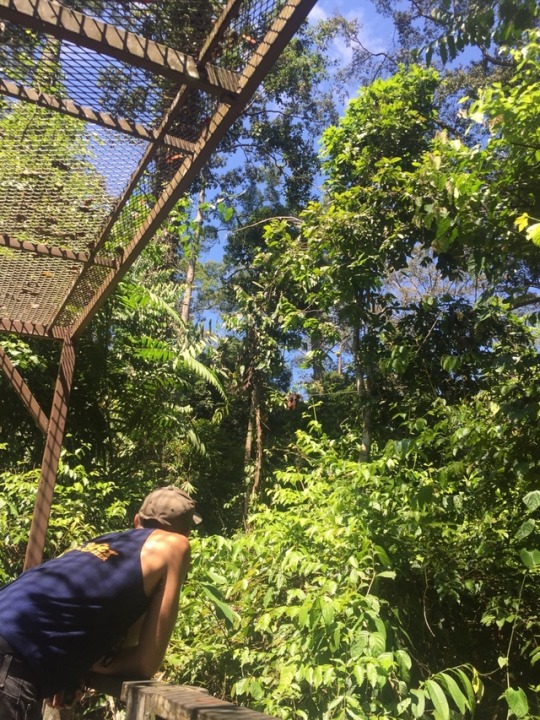
2 notes
·
View notes
Text
How can we un-fuck the planet?

Happy Earth Day!
Travelling around the world for the past few months has really made us appreciate how insanely incredible it really is.
Today is a day to celebrate the awesomeness of our one and only home - Planet Earth.
More importantly, though, it’s a day to recognise and acknowledge just how much we’ve truly fucked it up.
And most of that fucking-up has been done in our lifetimes.
Since the United Nations established its climate change framework in 1992, we’ve done more damage to the environment than we did in all the millennia that preceded it.
Or, as David Wallace-Wells puts it in his terrifying book The Uninhabitable Earth - “We have now done more damage to the environment knowingly than we ever managed in ignorance.”
It’s no longer a case of a few coastal towns being flooded at some far off point in the future. It’s going to start happening faster, on a bigger scale, and more severely than we’ve ever really considered. You can read a summary of the devastating impacts here.
This is not alarmist. It’s bloody terrifying and we should be scared. Climate change is the single most important story of our time and the greatest challenge any generation is ever likely to face. But rather than run around panicking or sticking our heads further into the sand we need to do something, anything.
So today on Earth Day why don’t we all try and have at least one conversation about our future, our children’s future, and the future of our planet.
Even better, let’s all try and do something to make a difference. To make things easier, here are some really simple, quick things that will not only help save the world but could also save you a load of money too.

What can we do right now to un-fuck the earth?
TAKE A STAND - To have an impact at the scale we need in order to avert, or even just minimise the disasters mentioned above, we need change at not just personal but local, national and global levels. Show your support for environmental movements and make your voice heard by supporting and voting for groups that are going to give our planet the best chance.
ACT NOW
Vote in the UK local elections on May 2nd. Check how all the UK parties rank on climate change here. Find your local council here. Find your local polling station here. Learn more about the local elections here.
Vote in the EU elections by May 26th. Find out how all the EU political groups & national parties rank on climate change here. Figure out if and how you can vote here.
Join a group like Extinction Rebellion - an international movement that’s raising the alarm and making serious demands of governments.
Sign a petition - like the one being led by Friends of the Earth which is addressed to the UK Government. You can sign it here.

SWITCH TO RENEWABLE ENERGY - This is actually one of the easiest and quickest things you can do to significantly reduce your carbon footprint almost immediately. Not only does it take minutes it could save you a load of money too.
ACT NOW - Come on, you knew it was coming. You’ve heard it before but I’ll say it again. Switch to Bulb today (if you live in the UK). It will genuinely take just a few minutes and you could save up to £356 on your energy bill. You’ll also get £50 credit if you do it by clicking my mate Georgie’s referral link here: https://bulb.co.uk/refer/gdale

FLY LESS - Very few of us are going to stop flying altogether. We’ve obviously taken a few flights during this trip but we’ve tried to plan it so that we only do so when we really have to. Just cutting down by one flight can have a massive impact. 1 return flight from London to Malaga contributes the same amount of CO2 as eating beef 1-2 times a week for an entire year.
ACT NOW - Find a way to take just one less flight. When you really do have to fly, fly direct since planes burn the most fuel during takeoff. You can also try and compensate for it by investing in green projects such as those featured on the United Nations Carbon offset platform, something we’re doing for all our flights during this trip.

EAT LESS MEAT & DAIRY - In western countries, we need to reduce our beef consumption by an insane 90%. Again, very few of us are going to turn into vegans overnight but what about just eating a bit less meat? We’ve found it surprisingly easy to cut down on our red meat during our travels and that alone can have a huge impact. We were even lucky enough to try an Impossible Burger in Singapore. Tasted just as good, if not better, than most burgers we’ve ever had and it’s made entirely of plants!
ACT NOW - Do Meat-free Mondays. If you and your family skipped meat and cheese just one day a week that would be the equivalent of not driving for five weeks. Also, eating seasonal, locally produced food has a huge impact. So maybe cut down on those avocados too - you might just save some money as well.

TALK ABOUT IT - One of the most important things you can do to fight climate change is to talk about it. People might not yet realise it but it’s going to affect every single one of us. So finding ways to talk about it through shared values is key. If we’re going to save the planet we need as many people as possible to get involved.
ACT NOW - Share this post, something else you’ve read today or even write something yourself. Do something, no matter how small and then tell people you did it - share your act of green. Take a naked selfie of yourself in the garden and hashtag the shit out of it for all I care. Just do something to help get people talking about climate change.
If you want to find even more easy ways you can help to save the planet, check out the UN’s new ActNow chatbot here, or take the WWF’s 30 Day Challenge here. Like this post, they’re designed to give you the power and knowledge to take personal action against climate change.
And finally, I’ll leave you with some words from the great man himself, Dave.
“Right now we are facing a manmade disaster of global scale, our greatest threat in thousands of years: climate change. If we don’t take action, the collapse of our civilisations and the extinction of much of the natural world is on the horizon.”
So what are you waiting for? Go un-fuck the planet. Now!
#ClimateChange#UninhabitableEarth#EarthDay#EarthDay2019#Earth#Environment#ClimateAction#ExtinctionRebellion#ImpossibleFoods#ImpossibleBurger#Bulb#BulbEnergy#IAmEurope#Connect2Earth
2 notes
·
View notes
Text
Reading our way around the world.

Before we started our trip we decided to make sure we each read at least one book that is set in or about each of the countries we visit.
We really want to try and get a proper taste for the places we’re travelling through. Taking local transport. Eating at local spots. Staying at home or farmstays. Visiting historic sites. Supporting local social enterprises. Talking to people about what it’s like living there. All these things have helped to start to gives us a feel for a place. We’ve also found reading has proved to be another really useful and fun way of helping us understand the histories, cultures and peoples of the countries we’ve been travelling through.
Here’s a list of books that we hope might provide some inspiration for you if you plan on visiting any of these amazing counties - or if you’re just looking for something to help you escape during your commute.
We’ll keep adding to it as we go so feel free to pop back occasionally to see what else we’ve been reading.
Click on the title to find out more about each of the books.
Nepal🇳🇵
House of Snow - Ed Douglas
This as an incredible introduction to Nepal. A massive collection of fiction and non-fiction pieces inspired by the insane landscapes and rich and sometimes complicated cultural heritage of this epic country.
While the Gods Were Sleeping: A Journey Through Love and Rebellion in Nepal - Elizabeth Enslin
The personal story of an American sociologist who moves to Nepal after marrying a Nepali man. She writes honestly about the challenge of adjusting to her new life in rural Nepal and trying to fit into a culture so different from hers.
Thailand 🇹🇭
Fieldwork - Mischa Berlinski
The amount of research that went into this book is incredible. It’s a great story set in the hills of northern Thailand that often feels so real it could be a true account found in an anthropology textbook.
The Beach - Alex Garland
Even if you’ve seen the movie with Leo DiCaprio, the book is still a great read. Richard’s internal monologues pull you in and brilliantly reveal his eventual emotional and mental breakdown.
Anna and the King of Siam - Margaret Landon
Based on the true story of Anna Leonowens, a young Welsh teacher who ended up in the Siamese court in Bangkok, teaching King Mongkut’s numerous children and wives for six years from 1862. Her liberal, humanist beliefs were at great odds with the king’s tyranny and the country’s archaic traditions, but she eventually had a huge impact on the young crown prince who later on abolished slavery and set the bases for modern Thailand.
The Windup Girl - Paolo Bacigalupi
Set in an intricately believable futuristic Thailand, this book takes aspects of current day Thai culture and twists them into a brilliant sci-fi story. As all good sci-fi books do it poses fascinating philosophical questions. What Happens when calories become currency? What happens when bio-terrorism becomes a tool for corporate profits? Quite dark and depressing at times but very entertaining.
Sightseeing - Rattawut Lapcharoensap
A collection of short stories that provide a diverse, funny, and deeply affectionate view of life in a small Southeast Asian country that is inevitably facing ever encroaching westernisation.
Laos 🇱🇦
The Coroner’s Lunch - Colin Cotterill
This book provides a really funny and entertaining way to get a feel for what life was like in Laos in 1976, after the communist takeover. Told through the eyes of the loveable Dr Siri Paiboun you learn masses about Laos culture history without even realising it.
One Foot in Laos - Dervla Murphy
Dervla is a badass Irish travel writer who cycled around the world. At the age of 67 she visited Laos, hiking and cycling her way through the mountainous country. Her book is written with great wit, charm and empathy, and it provides a wonderful insight into the lives of rural Lao people whom she’s very fond of.
A Great Place To Have A War: America in Laos and the Birth of a Military CIA - Joshua Kurlantzick
This incredibly well-researched book reveals how the USA was able to run a 9-year war without the world noticing, and the devastating impact it had on Laos.
Vietnam 🇻🇳
The Beauty of Humanity Movement - Camilla Gibb
This captivating story is told in contemporary Vietnam but provides a huge amount of insight into the impact of the conflict and turmoil the people of this country faced over the decades. A story of loss and longing but also filled with hope.
Cambodia 🇰🇭
When Broken Glass Floats: Growing Up Under the Khmer Rouge - Chanrithy Him
A harrowing, first-hand, child’s account of what it was like to live through the hell of the ‘Cambodian Killing Fields’. Chanrithy doesn’t pull any punches and at times even reading can get a bit tough. But in the end, the thread of the strength and love between her family pulls you through.
World 🌎
Only Planet - A Flight-free Adventure Around the World - Ed Gillespie
An amazing book about Ed’s journey around the world without getting in a plane. His ability to express his observations and beliefs so eloquently means it’s full of things you want to quote all the time. His attempt to reconnect with communities and our planet in a sustainable way has been a real inspiration for our trip.
3 notes
·
View notes
Text
Bogi’s dream came true: we visited a coffee farm
Laos probably doesn’t spring to mind when you think of coffee, but it’s the world’s 22nd biggest coffee producer, and coffee is a key part of everyday life - something I was very pleased to see upon arrival. In Luang Prabang and the capital Vientiane there are plenty of swanky coffee shops to choose from, and they all proudly serve Lao coffee. It actually made me think, how it nice it must be to live in a country that grows its own coffee, as opposed to having to import it, which obviously makes your cuppa more expensive and a lot worse for the environment. The lucky Lao!
Coffee is one of the very few things the Lao can thank the French for. As colonisers go, the French were rather useless: they built no infrastructure, no schools, they simply invaded Laos because it’s wedged between strategically more important countries they also wanted to invade. That aside, the clever French figured that the Bolaven Plateau in Southern Laos, with its volcanic soil and hot climate, is ideal for growing coffee plant. Merci guys.
I first read about Mr Khamsone’s coffee farm tour on a blog as we were researching Laos (because, quite frankly, we knew very little about the country). With great skill, I managed to convince MJ to come back to Laos after travelling through the North of Vietnam - not knowing that this will manifest in a gruelling, 24 hour journey that would see us being dropped off a sleeper bus at 4:30 am at some unattractive town’s Soviet-inspired bus station, then standing on the side of a road in hope of being picked up by another bus that would actually take us to Laos.
It’s gonna be worth it, when we get there! - I kept saying to the man who can’t even drink coffee.
Anyway, we made it back to Laos, and the next day we were on our way to a village called Paksong, to meet Mr Khamsone. He said he’d pick us up in his jeep to take us to his coffee farm - and so he did, rocking up at our meeting point like some bad ass chauffeur in what turned out to be a 70 year old Chinese jeep. Despite its appearance (think WWII tank) it did a pretty good job at tackling the infamous Laos ‘roads’. We were given huge plastic bags and medical masks (always a good sign when getting into a random person’s car) to protect our bags and lungs from ‘The Dust’. The beauty of this part of the world is that you’ve got 2 options: in dry season it’s the omnipresent Dust that gets into everything and sticks brilliantly to sweaty skin, or in the rainy season the roads become so muddy that you can’t get anywhere.
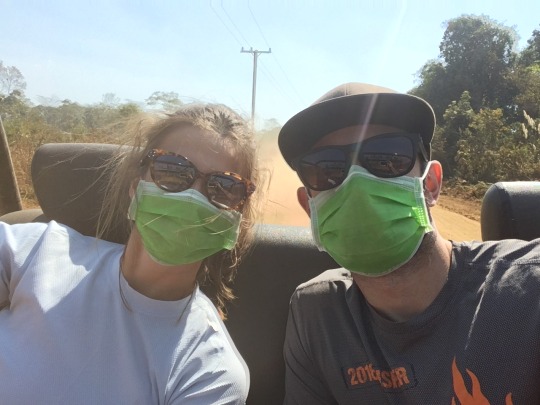
The thoughtful Mr Khamsone’s itinerary really took the sweat and dust situation into consideration, and so our first stop was at a remote waterfall where we could go for a refreshing swim. Then we were taken to another waterfall, this time parking our jeep in the water because, why not. We got into the lake and swam through the cascade of water into a little cave, which turned out to be more challenging than we’d thought: the sheer power of the water creates a strong ‘wind’ that pushes you away, and the closer you get, the louder it becomes.
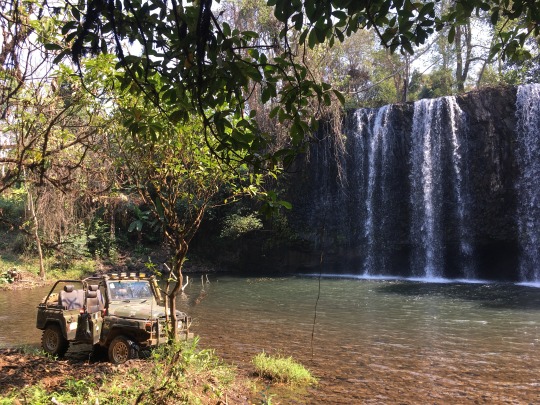
After all the aquatic fun, we drove to a nearby village where literally everyone makes a living from coffee. This time of the year is great for visiting as we could see the various parts of the process all around the village: freshly picked coffee berries were laid out to dry in the sun; some people were operating a rather DIY looking machine getting the dried skin off the beans, others were sitting on the ground sorting through bags of green beans and categorising them, hand-picking the best ones and discarding the ones that have even a tiny bit of defect.


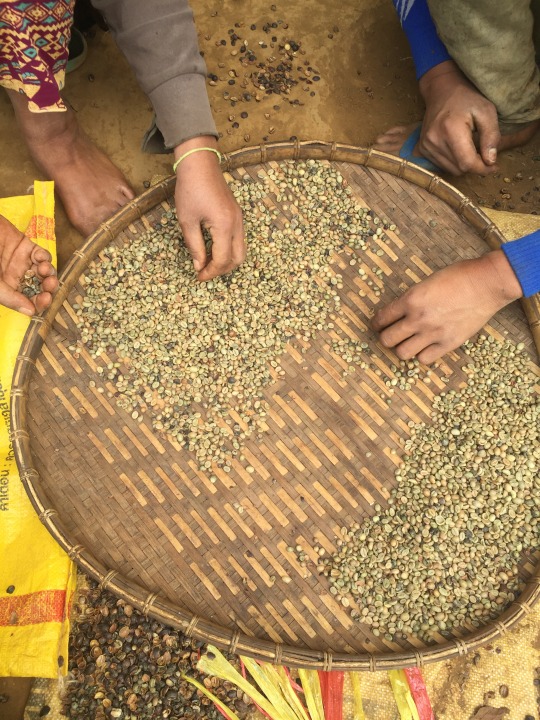
Walking through the village, the labour intensive nature of growing coffee really hit us: you realise how much work goes into a single cup of coffee, how many hands touch the humble bean before it even gets sold to roasters, and then to coffee shops. When your barista hands you your £2.50 flat white in a painfully cool cafe in Central London (like I used to do), you don’t think of the farmers growing the beans, whose name might be mentioned somewhere, but you’re even less likely to think of the dozens of anonymous workers who nurtured, picked, processed and selected the beans so that you can face the day and the numerous pointless meetings you’ll have. And I guess that’s fine - as long as these people are paid and treated fairly.
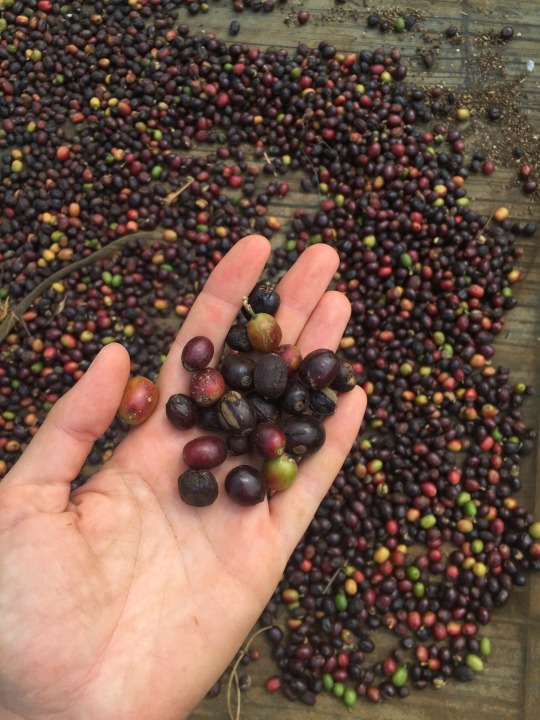
In this part of Laos, both Robusta and Arabica varieties are grown. The cheaper and stronger Robusta tends to stay in Laos and is consumed by the locals, while the more expensive and high maintenance Arabica is exported, mainly to the neighbouring countries. There’s more money in Arabica but it also needs a lot more care and attention, so it’s a bit riskier. Mr Khamsone tells us how in 2014 he lost a lot of money when 6 hectares of his coffee farm was hit by frost. Since then, all his coffee plants are grown in the shade, protecting them from extreme temperatures.
After a delicious home made lunch at Mr Khamsone’s house, we were shown around the coffee farm itself - a much awaited highlight of the day. I’d never been to a coffee farm in my life, in fact, I’d never seen a coffee plant in its natural habitat, so I was well excited. Drinking my post-lunch coffee whilst walking around the plantation where is was grown, it was like Christmas for me.

The farm itself is truly beautiful. It spreads over 16 hectares on the slope of a small hill. Just like a well-maintained vineyard, the trees are planted in neat rows, each one exactly 2.5 metres from the other. What makes the farm particularly pretty is the acacia trees that are planted purposefully to create a canopy over the coffee plants and protect them from the heat and cold.
I can only imagine how nice it all looks with the berries still on the plants, but the harvest had happened a few weeks ago so it was all just beautiful green.
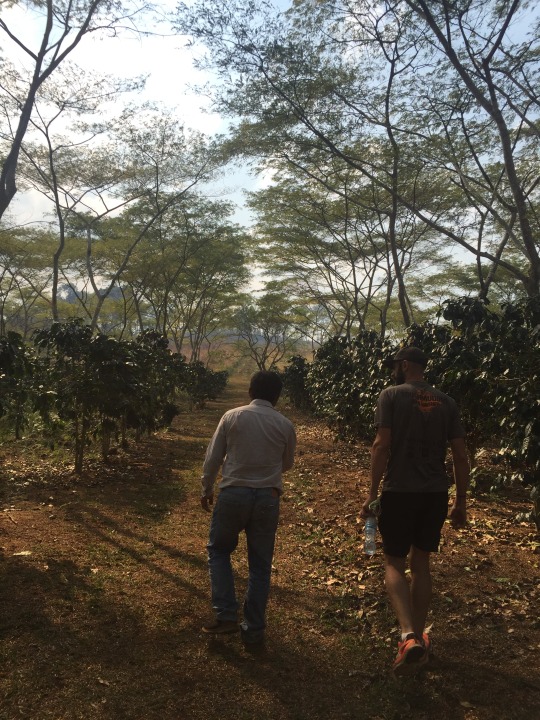
After the tour of the plantation and a gentle hike to the hill, we returned to the farm to roast some coffee. At this point I was properly taken back to my dad’s place in Hungary, where he makes his famous (infamous?) palinka, a punchy fruit brandy many of my friends are familiar with. He distills them from various fruits in the back of his garden, and whilst the process is 100% legit and he knows what he’s doing, it does look a bit home-made. No fancy equipment or sterile labs, just basic tools and a lot of expertise.

Standing in Mr Khamsone’s back yard in rural Laos, I got a sense of admiration - in the middle of nowhere, this guy has built himself a coffee roasting machine. It’s a clever piece of Lao engineering: a massive metal drum rotated above a grill that is fuelled by gas from a canister. I got to contribute to the process by expertly managing the handle that rotates the drum.
In a more professional environment you’d time the roasting and you’d have a little window allowing you to see how the beans are doing in there, but Mr Khamsone is a man who doesn’t need all that fancy tech. He knows when his coffee is ready by the smell alone.
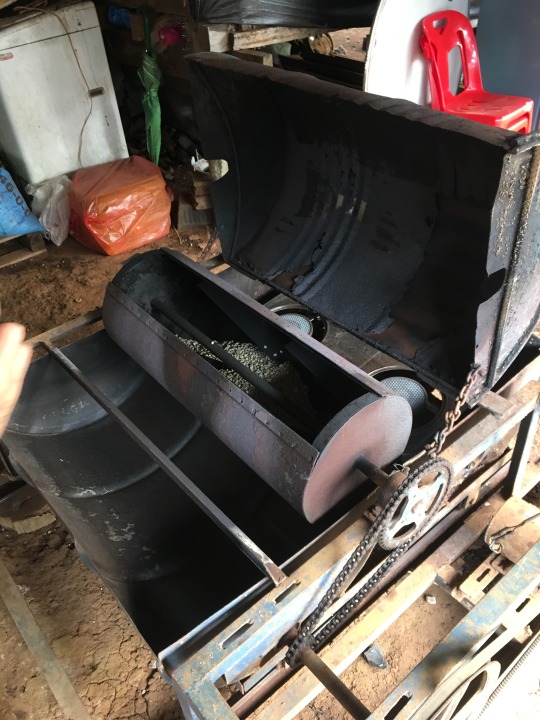
He explained the different phases of roasting to us: first it smells like popcorn, then in 5-10 minutes it’s like a bakery, then chocolate, and finally, at about 15 minutes, it smells like what it is: freshly roasted coffee.
Opening the roasting drum, it again felt like Christmas Day. The beans were now dark brown, shiny, slightly smaller than before, and they smelt amazing. Sadly we couldn’t try them as they needed to rest and release some CO2 for a few days. But we did get a bag of beans roasted a couple of days before, to take with us.

Before we finished our tour and headed back to Paksong, we walked through another part of the village and chatted about Mr Khamsone’s plans. He wants to build couple of bungalows above his farm, on top of the hill, so his guests can enjoy the amazing view. He even talks about a yoga retreat. While he’s happy to see more tourists visiting his farm and the area, he’s strongly against tour agencies bringing in big groups of tourists. We totally understand why he’s keen to keep his tour small scale and intimate.
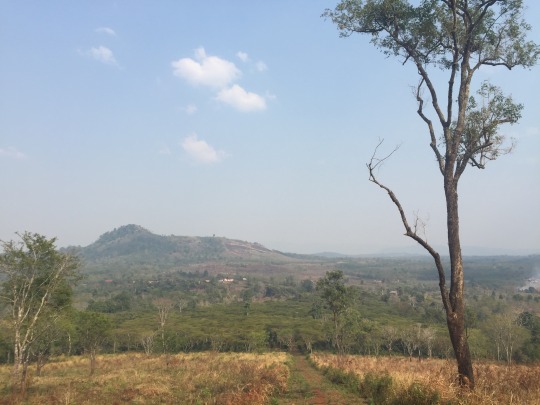
We feel lucky to have had such an authentic experience, and got a glimpse of how some Laos farmers and rural people live their lives. From a tourism point of view, Laos is still less popular than its neighbours (being landlocked sucks! Take it from a Hungarian) but there’s so much to see and experience there, and the people are absolutely amazing; one of the friendliest, most relaxed people we’ve met. We feel that as a country still recovering from a devastating war that saw the US bombing it for 9 years, Laos deserves the attention of the world. So if you ever get a chance to visit this part of Asia, give Laos a chance.
Or just look out for Lao coffee in your local coffee shop.
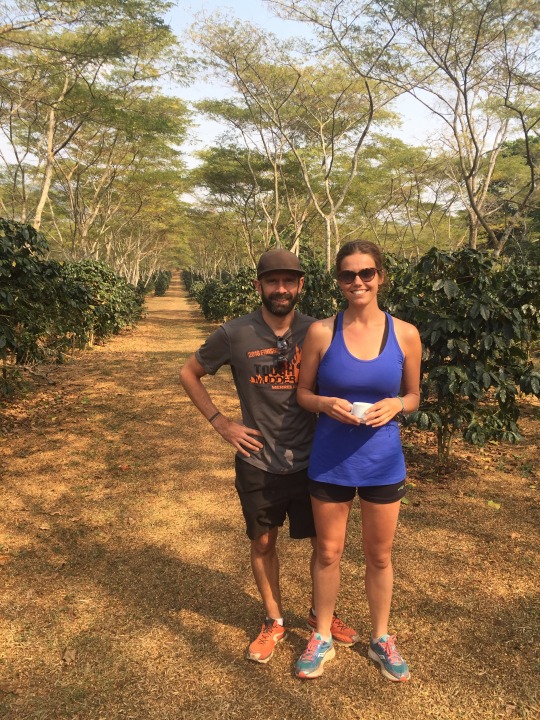
2 notes
·
View notes
Video
youtube
In video number three we explore three incredible places in northern Thailand. It used to be known as Lan Na or the Lanna Kingdom - the ‘Kingdom of a Million Rice Fields’.
Our first stop was Chiang Mai, the last capital of the old kingdom. Here we wandered through scores of beautiful temples, sampled the local cuisine in mad bustling markets and watched as people released hundreds of sky lanterns as we counted down to the beginning of 2019. The soundtrack to this is a song by Thonghuad Faited, ‘Diew Sor Kid Hod Baan (Sor Solo - Missing Home)’. It features the ‘sor’or ‘saw duang’, a traditional two-stringed violin from northeast Thailand.
Then it’s up to Pai, a relaxed little town further up in the hills near the Burmese border. It provided a great base for us to explore the surrounding area and its geological wonders. The ‘Pai Land Split’, which cut a farm in half, was caused by three earthquakes between 2008 and 2011. Tham Lod Cave is not only an incredible spectacle but a site of significant archaeological significance with evidence of being occupied from as far back as 9000BC. Pai Canyon consists of a number of narrow paths shouldered by steep drops into deep ravines. As you’ll see, it’s a great place to scramble around and watch the sun set over the entire valley. The soundscape to these landscapes is the beautiful Thai folk song ‘Kang Krow Kinkroy’ by Kalae.
And finally, Chiang Rai, which contains some of the most bizarre temples we’ve seen so far. Both the white and blue temples feature a delightful clash of traditional and contemporary Thai culture. There was therefore only one song that could possibly do them justice - the incredible Thai cover of Ed Sheeran’s ‘Shape of you’ (a Thai favourite) by Neww.
2 notes
·
View notes
Text
How can green river algae help street kids?
‘Khaiphaen’ is a Laotian snack made from freshwater green algae or river weed. Sounds a bit gross but it’s actually delicious. It’s also the name of a fantastic little restaurant in Luang Prabang, Laos.

Bogs tucking into some delicious green algae.
Khaiphaen is a social business founded by Friends International as part of Tree, a global alliance of training restaurants. It provides opportunities for children, youth and caregivers living on the streets and in marginalized communities in Vientiane and Luang Prabang.
As we’ve learned, Laos has experienced significant economic growth in recent years. A big increase in wealth has meant that it’s eligibility for graduation from Least Developed Country status has been confirmed. As good as that all sounds, 23% of the population still live under the poverty line. That, coupled with the fact that huge numbers are moving to the cities (at a rate which is the second fastest in Southeast Asia), has created increasing levels of urban poverty. As ever it's the children that end up suffering the brunt of the marginalisation.
Peuan Mit (“Good Friends” in Lao) is a program for these marginalised communities in Laos. It runs a number of different social businesses and has assisted thousands of marginalised children, youth and caregivers.
Khaiphaen is one of those businesses. It provides young people with the training and skills needed in hospitality, giving them brilliant employment opportunities in Luang Prabang’s booming tourism industry.
Not only though, does it does it have a positive beneficiary impact on the community, it’s also a damn good restaurant. The food was absolutely delicious - a creative mix of Laos cuisine that’s ideal for sharing - and the service was amazing. Both the students and the teachers (identifiable by their smart polo shirts) were extremely friendly and very attentive.
In the corner of the restaurant is another Peuan Mit social business - a small fair trade shop called Friends ‘N’ Stuff. Using mainly sustainable materials, it sells products made by members of their Home Based Production program (parents in need) who receive training, a stable income, social support, and employment assistance.

She does love a gift shop.
We loved the place and the people so much we decided to make a very small donation by buying a brick in their wall. The money they receive goes towards funding training for students like the ones who served us.

Us with a couple of the awesome Khaiphaen students and their teacher.
If you ever find yourself in Luang Prabang or even just passing through we’d definitely suggest popping in. Even if it’s just to try their delicious green algae based snack, you’ll be helping build the futures of street kids too.
0 notes
Text
How to protect children whilst travelling.
Our first two days in Laos were spent on Southeast Asia’s most iconic river, ‘the mighty Mekong’, as the locals like to refer to it.
As we meandered our way slowly down towards Luang Prabang, we often stopped briefly at small settlements. Locals would hop on and off and we’d drop off all sorts of deliveries from chickens to mopeds.

One of many riverside settlements along the Mekong.
At one such stop, the boat was attacked by a hoard of extremely young children. They clambered onto the sides of the boat, leaning in with fists full of bracelets and purses hoping we, along with our fellow tourists, would buy some.
Many on the boat found this all very cute, with some taking photos and others even handing out dollar bills to the kids. Unfortunately, it just made us feel rather uncomfortable.
Wasn’t this all a bit wrong?
Were we treating them like zoo animals?
Shouldn’t these kids be in school?
As the boat pulled away we smiled and waved goodbye to the children with a slightly bitter taste in our mouth. We couldn’t quite decide if we were being mean or not.
On arriving in Luang Prabang however, we came across a leaflet that not only confirmed our feelings but provided some brilliant advice for us and other travellers.
We wanted to share this advice as we think it’s something super important but is something many may not be aware of.
7 TIPS TO PROTECT CHILDREN ON YOUR TRAVELS
1 - Children are not tourist attractions - let’s not treat them like they are.
2 - Volunteering with children feels good but could be harmful - look for better ways to help them.
3 - Children pay a price for your generosity - don’t give to begging children.
4 - Professionals know best - call them if you think a child needs help.
5 - Sex with children is a crime - report child sex tourism.
6 - Children should not be at work instead of school - report child labour.
7 - Protect children - be a ChildSafe traveller.

To find out more on how you can protect children better and join the ChildSafe movement visit ThinkChildSafe.org
Your next trip could be an opportunity to make a real difference.
1 note
·
View note
Text
Can you change the world at breakfast?
Well, maybe not the whole world, but you can make part of it a little bit better.
We just popped into Free Bird Cafe in Chiang Mai for a delicious vegan breakfast. But eating food that’s been ‘ethically, responsibly and thoughtfully sourced’ isn’t what makes a trip to this little cafe special.

Bogs enjoying a pancake that’s doing a little bit more than just being vegan.
Free Bird Cafe, is actually a brilliant example of a socially driven business. Set up in 2009 by Thai Freedom House, it’s designed to help keep the charity’s operations running. 100% of the profits from the cafe and the attached zero waste shop, My Best Life CNX, help refugees escaping from bordering Shan state in Myanmar, along with minority peoples of Thailand.

Chaing Mai’s first Zero waste store - My Best Life CNX
Thai Freedom House provide a safe place for their students to create a new community and build their self-confidence, basic language skills, critical thinking skills and creatively express themselves.

Students showing their love. Image by Thai Freedom House.
But Free Bird Cafe’s social good doesn’t end there. They also choose their wonderful staff from the most at-risk population who are served in the learning centre and provide training and support for them in the hospitality industry.

So, whilst we didn’t change the world this morning, we did manage to support a brilliant organisation, and all we had to do was enjoy some delicious grub.
Not a bad start to the day.
#FreeBirdCafe#ChangeTheWorldAtBreakfast#SocialGood#SocialEnterprise#ThaiFreedomHouse#Vegan#GoodCause#NGO#NFP#ChaingMai#Thailand
0 notes
Video
youtube
Here’s another very rough film which gives you a taste of our time on Koh Chang, Thailand. The Thai phrase ‘sabai sabai’, which can be translated as "everything's chill" or "not a care in the world", sums it up perfectly. It is wellness almost beyond words, the Thais' heaven on earth.
This time the soundtrack is a song by Jah Jah Land who performed live at the Indie Beach Christmas BBQ. To have a proper listen, check it out on Soundcloud.
0 notes
Photo

Today we were Trash Heroes ♻️🚸♻️ This year, on World Environment day, the UN highlighted plastic waste as being one of the biggest environmental threats facing the world. It's an issue that's of paticular concern in Thailand, with experts claiming the country's becoming the 'garbage bin of the world'. So, on Boxing Day, a time when people around the world will be experiencing bins full of packaging from the previous day's present giving, we decided to see if we could make a small dent in the world's waste woes. Thrash Hero is a global movement aimed at keeping our world clean for future generations, by bringing communities together to clean and reduce waste. We joined the Koh Chang Trash Hero group on their weekly trash picking event. We joined another 20 volunteers eager to spend some time clearing a section of the south part of the island near Bang Bao. We collected a total of 34 bags of garbage, adding to the nearly 20,000 kg the group have already collected since they started in April this year. To learn more about the movement and find out how you can help keep our world clean for future generations check out Trash Hero World.
1 note
·
View note
Photo

สุขสันต์วันคริสต์มาส! Merry Christmas! Boldog Karácsonyt! We swapped our wreath for an inflatable ring this year.
0 notes
Photo

Temples and street food 🍜 When you only have 24 hours in Bangkok you want to maximise the number of Buddha statues seen and the calories consumed. Think we nailed it 👍
0 notes
Video
youtube
Here’s a very rough film we’ve smashed together to document our 6 day trek in the Annapurna region of Nepal. The awesome song in the background, ‘Pirim Nalaune’, was the number 1 tune in Nepal at the time and was played absolutely everywhere. For those who want to have a proper listen and check out the incredible music video (you know you want to), check it out here.
0 notes
Text
The spirit in me greets the spirit in you.
It’s our 4th day of trekking in the Annapurna Conservation Area, and for the first time, we’re feeling like we’re a bit lost.
We must have taken the wrong exit from Tadepani where we stayed last night, and we’re now heading towards Ghandruk - the biggest town in the area we decided to avoid.
The thin path we’re on crosses a beautiful, lush jungle, but there haven’t been any signs for a while and we haven’t seen a single human being for an hour - which is actually quite nice. We’re kind of enjoying the peace and quiet, and not having to overtake groups of trekkers. Off the beaten track! Excellent. Until I suddenly remember a Nat Geo programme we watched a while ago about tiger conservation in Nepal and neighbouring Bhutan. I wonder what the likelihood of being eaten by a stray tiger is. I keep staring at innocent ferns and bushes, paranoid that there’s a hungry tiger hiding in them. MJ gives me some reassuring data points, I do some yoga breathing, and we carry on walking. Teamwork at its best.
Guided by the distant sound of bells signalling buffalos and the occasional rubbish on the path (Rubbish! Humans! Yay!), we finally emerge from the jungle. On our left, the Himalayas stretch with their snow-capped peaks in the clouds, on our right there’s a massive sunny valley surrounded by green hills and terraces. In the middle, there’s a ridge with what looks like a path on it. A sign is saying Little Paradise: 25 mins.



Over the past few days, we’ve learnt that before you reach a village/teahouse/your final destination, there’s always a steep ascent; most often manifested in those bloody steps we must have climbed multiple thousands of by now.
Good things come to those who are willing to defeat elevation - and this couldn’t be truer than today.
On the top of the hill, we find a little guesthouse surrounded by a huge, beautifully maintained garden and some trees that shelter it from the wind. The sun is shining, chickens are running around, and we spot a doggo and her puppy playing in the grass.
Have we found Paradise?

‘Namaste! Is anyone here? Excuse me, Namaste!’
We finally find a bloke who is happy to make us a masala tea and some veggie egg fried rice - our usual lunch menu. He seems to make everything from scratch, something that we’ve been very happy to see in the local teahouses. Most people in the Gurung villages of this region have their own vegetable garden or plot of land, and they own chickens, cows, goats and sometimes buffalos. It makes sense, and is a necessity when you live so far off from shops and the higher up the hill you live, the more you have to pay to get anything delivered.
After serving our food, the bloke joins our al fresco lunch, and we start to chat. He’s got excellent English, and like most Nepalis we’ve met, he’s very friendly, polite, genuinely interested but never pushy. He tells us he grew up in Kathmandu and then set up his business on this remote hilltop 20 years ago, and he’s been running it with his family ever since. He’s got a 4-year-old daughter, a sweet little girl we’ve seen running around in the garden, wearing an amazing tutu over her traditional Nepali clothes. She’s going to have to go to school next year - her commute will be walking down the path to the nearest village in the valley, with an epic backdrop of the Annapurna range.
There’s no other guest at Little Paradise at the moment - unsurprising, seeing that it’s low season and this hill is not on the main tourist path. Our guy tells us most people find them by accident, just like us. He doesn't want to advertise the lodge too heavily, and he certainly doesn't want local tour agencies to bring in any large groups. It might seem like a luxury, relying on the odd trekker to stumble upon them, but the amazing thing is that he knows perfectly well that that would totally ruin the vibe. MJ and I have seen teahouses invaded by big groups of (mostly wealthy Chinese) trekkers, with their guides and porters visibly keen to fulfil their every request, and teahouse owners prioritizing them at dinner time, serving them a 10-course feast whilst you’re waiting for your humble noodle soup to arrive.
Our bloke tells us they are fully self-sufficient: they grow all their food, have some cows and chickens, and they’ve installed solar panels to generate electricity. So, in theory, they could do without guests. No wonder he’s so chilled about marketing; he knows that his happy guests will recommend them to their friends, or write a good review on Facebook.

What we’ve found with these teahouses is that they’re willing to give you a room for free or for virtually no money, if you have dinner and breakfast with them. Of course, we’re lucky to be here in December, at the start of the low season, after the super busy October and November. We’re quite pleased with our timing - the air is crisp, the sky is blue, visibility is pretty good, there aren’t many tourists, and the prices are low. Teahouses are thrilled to have you. The only thing is the cold. Turns out the rooms in the teahouses are not heated - in Ghorepani (2860m) the temperature in our room dropped to below 0 degrees at night. You literally sleep in all your clothes, wearing your woolly hat and gloves, and if you’re lucky they’ll give you a blanket you can throw over your sleeping bag. The only slightly warmer room is the dining hall where they normally have a barrel-turned-wood burner and some hangers above it so at least you can dry your sweaty clothes and damp towels.


Even though we only did a 6-day trek, we met a few people who were going up to ABC, aka Annapurna Base Camp. Now that’s even more nomad. Because it’s in the Conservation Area, teahouses are not allowed to use woodfire, so there’s no heating anywhere. You need a sleeping bag that keeps you alive in -20 degrees. At over 4000 m, the ABC is a punchy destination, and we totally don’t regret not doing it.
Over the course of the week, we settled into a daily routine of an early start, breakfast and coffee (for me), setting off at about 9 am, then after a quick lunch break, we usually arrived at the next village early in the afternoon. We never booked accommodation in advance; we just went with our intuition and always found nice places for not a lot of money. As the altitude increases, so do the prices, but even in the most expensive teahouse, we paid a total of app. 2500 Nepali rupees (£20 ish) a day.

Hot showers, masala teas, thick duvets and hard mattresses kept us going. Our diet was safe and bland (mainly veggie momos, fried rice or noodles, nothing extravagant.) Thank God and my Mum for the endless supply of Snickers we took with us, those little bars do pack a punch and certainly made the ascents a lot more bearable.

Physical challenges aside, our week of trekking in this beautiful part of the world was nothing short of epic and memorable. Every day we got to enjoy a totally different landscape: never-ending steps leading us to picturesque hilltop villages, lush forests, waterfalls, suspension bridges, all with a backdrop of the majestic Annapurna Massif, Annapurna South and Dhaulagiri. The best place to see all these mountains in a breathtaking panorama is the popular Poon Hill pilgrimage. We did this not once, but twice. Each time climbing up for an hour from our guesthouse in Ghorepani (2874 m) to 3210 m where you’re greeted with an unobstructed view of these giants.

Sunsets on Poon Hill are underrated - there was just us and two Italian girls on the top so we could fully enjoy the epic views and in the quickly changing hues of pink, before the lights went out and the peaks suddenly looked like huge ice shards in the crisp Himalayan sky.

The next morning, we woke up at 5, put on all the clothes we had with us, and set off in pitch black and what was probably a punchy -5 Celsius degrees. I won’t go into the details of my ungraceful struggle to reach the top before sunrise - suffice to say if it wasn't for MJ expertly encouraging me and at times physically dragging me, I probably would’ve just refused to keep going halfway through the hill. Should’ve had a bloody Snickers, or maybe some cardio training? Long story short, we made it, it was beautiful, although it was proper rush hour up on the top which made us appreciate our sunset session even more.

Back in lovely Pokhara, we indulge in what I believe are perfectly justifiable post-trek activities: eating non-Nepali food (found an AMAZING Middle-Eastern restaurant that would be impossible to get into if it was in London), lie-ins, drinking alcohol and super healthy juices and smoothies, a yoga session, an Ayurvedic massage (both me) and of course decent coffee, also by me.
On our last day, we say bye to Pokhara with a pretty special treat to ourselves; we book a paragliding session over Phewa Lake.
We will miss saying Namaste a hundred times a day. I didn't know this before coming here but Namaste in Nepali means something along the lines of ‘the spirit in me greets the spirit in you’. Hearing it from Nepali people makes so much sense: they’re one of the most welcoming, kind, open and humble people we’ve met. Nepal is not a rich country and it’s been through a lot of political drama; life in the mountains is extremely hard, and most people live in what we’d call poverty. And yet, everywhere we went, we were greeted by smiles and a Namaste, asked where we’re from, where we’re going and given directions, served food that was prepared with care, and genuinely made to feel welcome in this beautiful country.

Now we’re off to India and then Thailand, but we cannot wait to be back.
Danyabad, Nepal.
1 note
·
View note
Photo

Ending on a high ☁️☀️☁️ Turns out Pokhara is the world’s 3rd best paragliding spot so we thought it’d be rude not to. #yolo
0 notes
